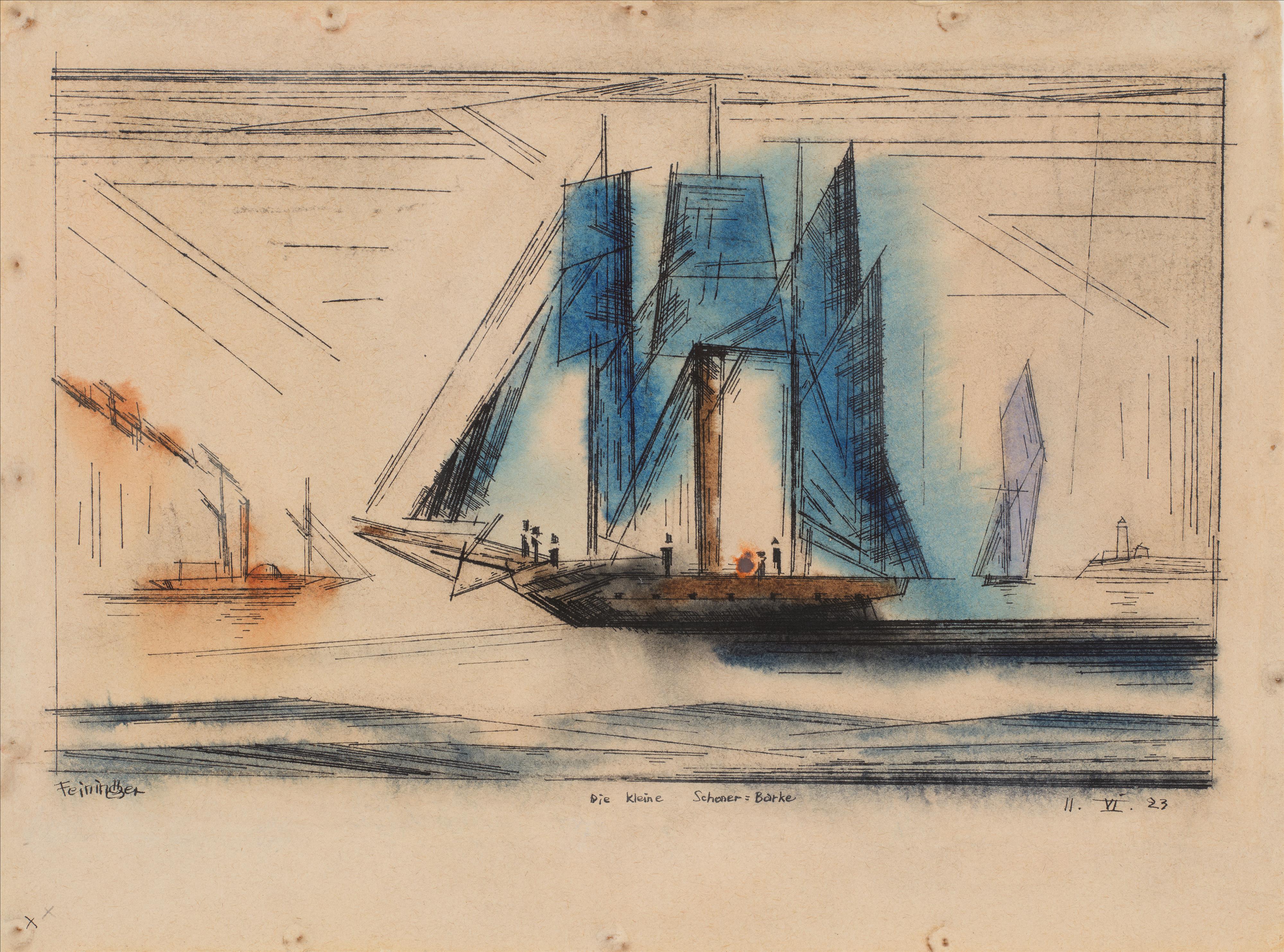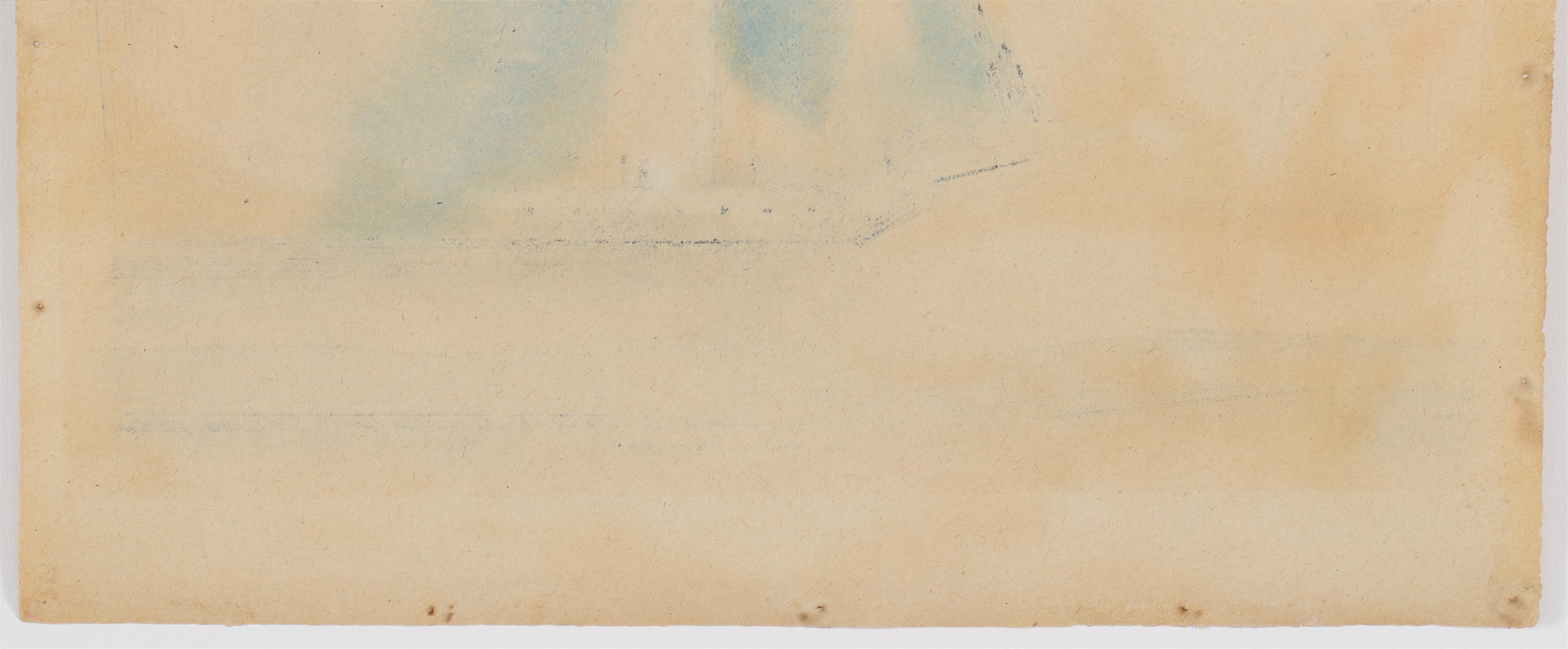Lyonel Feininger
Die kleine Schoner-Barke
1923
Pen and India ink, chalk pastel, watercolour and charcoal on fibrous laid paper. 27.8 x 37.6 cm. Framed under glass. Signed, titled and dated 'Feininger Die kleine Schoner = Barke 11.VI.23' in ink on the lower edge. - Slight overall browning and with studio-related pin holes in the corners from the studio.
Lyonel Feininger knew all of them by name – the schooners, sloops, paddle steamers, galleons, fishing cutters, and three-masted barques travelling along the East River or, later, on the Baltic Sea with full sails or smoking chimneys. Feininger loved to stand on the shore and become absorbed in the spectacle of the passing ships as though mesmerised. There is scarcely a motif that fascinated the German-American painter more than sailing ships and coastal landscapes. As Werner Timm writes in the catalogue of the major Feininger retrospective shown in Berlin in 1998: “Feininger [created] several of the 20th century’s most artistically important images of ships, although he was no painter of ship pictures in the traditional sense – more a poet occupying himself with a metaphor” (exh. cat. Berlin/München 1998, p. 308).
The collection of the Düsseldorf architect and town planner Walter Brune (1926–2021), whose fame extends well beyond the borders of Germany, is the source of the seven exquisite watercolours featuring maritime motifs that are now up for auction, including two design sketches for the decoration of the “Marine Transportation Building” in New York (Lots 3, 4). The earliest sheet from this group of works, “Stadt” (1921, Lot 6), was created before Feininger’s first stay in Dźwirzyno (then Deep) by the Baltic Sea. Before a backdrop featuring tall buildings and church towers, a sailing boat in red travels directly towards the viewer. Two smaller ships, which remain neutral in colour, embellish the riverbank. In contrast to the later seascapes, while the ship may be in the centre of the composition, Feininger is primarily interested in the various architectural structures behind it.
The most important period for marine paintings by Feininger were the twelve years from 1923 to 1935 in Dźwirzyno, a little bathing resort directly on the mouth of the Rega, near Koszalin (then Köslin) in Pomerania. In this area, Feininger encountered a long and pristine stretch of coast that could only benefit his maritime compositions. A seemingly endless beach, the hilly landscape of the dunes and the rugged, steep coast further to the west provided ideal conditions for transforming his approach to the beach and sea. In Dźwirzyno he initially created pictures focused purely on the beach and clouds, still lacking ships and only occasionally featuring isolated figures; however, what he primarily composed there were his numerous paintings and watercolours with stately sailing ships and fishing boats. The watercolours “Die kleine Schoner-Barke” (Lot 2) and “Boote am Strande I” (Lot 1) provide two fabulous examples from his early years in Dźwirzyno. Within the calculated composition of “Die Kleine Schoner-Barke”, he has placed the proud ship in the middle of the image. As it slowly sails past the viewer, two other ships respond to it on the left and right, but these are substantially smaller. The sky and sea occupy nearly equal amounts of space and Feininger has indicated them by means of parallel, mostly washed lines. The most important artistic devices here are the precise strokes of the pen and the subtle palette of blue, black and grey, with accents in orange. In the second sheet, “Boote am Strande I”, the scene has been arranged with nearly mathematical deliberation: the four sailing boats along the water’s edge which dominate the picture find a response in the little rowing boats, figures and hooded beach chair on the shore. “The network of pen strokes”, writes Gunda Luyken in a Feininger catalogue from 2016, “resembles oscillating lines of force which, even if they have been drawn using a ruler, never seem mechanical” (exh. cat. Düsseldorf 2016, p. 19). All of the sheets are characterised by the border that Feininger usually drew around his finished works and which relates back to the lines within the image.
After his return to the United States, he created the watercolour “Dreimaster und Segelboote vor der Küste” in 1943 (Lot 5). In contrast to the marine paintings created previously by the Baltic Sea, the three sailing ships here seem “dematerialised” and appear to hover above the water. Without the accustomed linearity – aside from the riverbank and the hills – Feininger has used transparently delicate colours, shades of lilac and various grey tones, to compose his watercolour. The flecks of colour reminiscent of raindrops reinforce the stillness and idealised character of this late marine picture. Although Feininger continued to create marine pictures into the 1950s, he wrote to his son in 1953 about how much he missed the Pomeranian coast as a source of inspiration: “What I really miss is drawing after nature and making ‘notes’, for instance by the Baltic Sea, in Deep […]. Somehow the motifs in this place do not suffice; they contain too few of my inner wishes […]” (cited in Hans Hess, Lyonel Feininger, Stuttgart 1959, p. 162).
Certificate
Achim Moeller, director of the Lyonel Feininger Project LLC, New York – Berlin, has confirmed the authenticity of this work, which is registered with the Lyonel Feininger Project under the no. 1828-02-10-23. Certificate enclosed. With a photo expertise by Charles B. Feininger, the artist's grandson, dated 26.1.1999 and a photo-certificate by Ulrich Luckhardt, Hamburg, dated 20.2.1999.
Provenance
Collection Charles Feininger, 1999; Galerie Gmurzynska, Cologne, 2000 (labelled on the backing card); Collection Walter Brune, Düsseldorf




